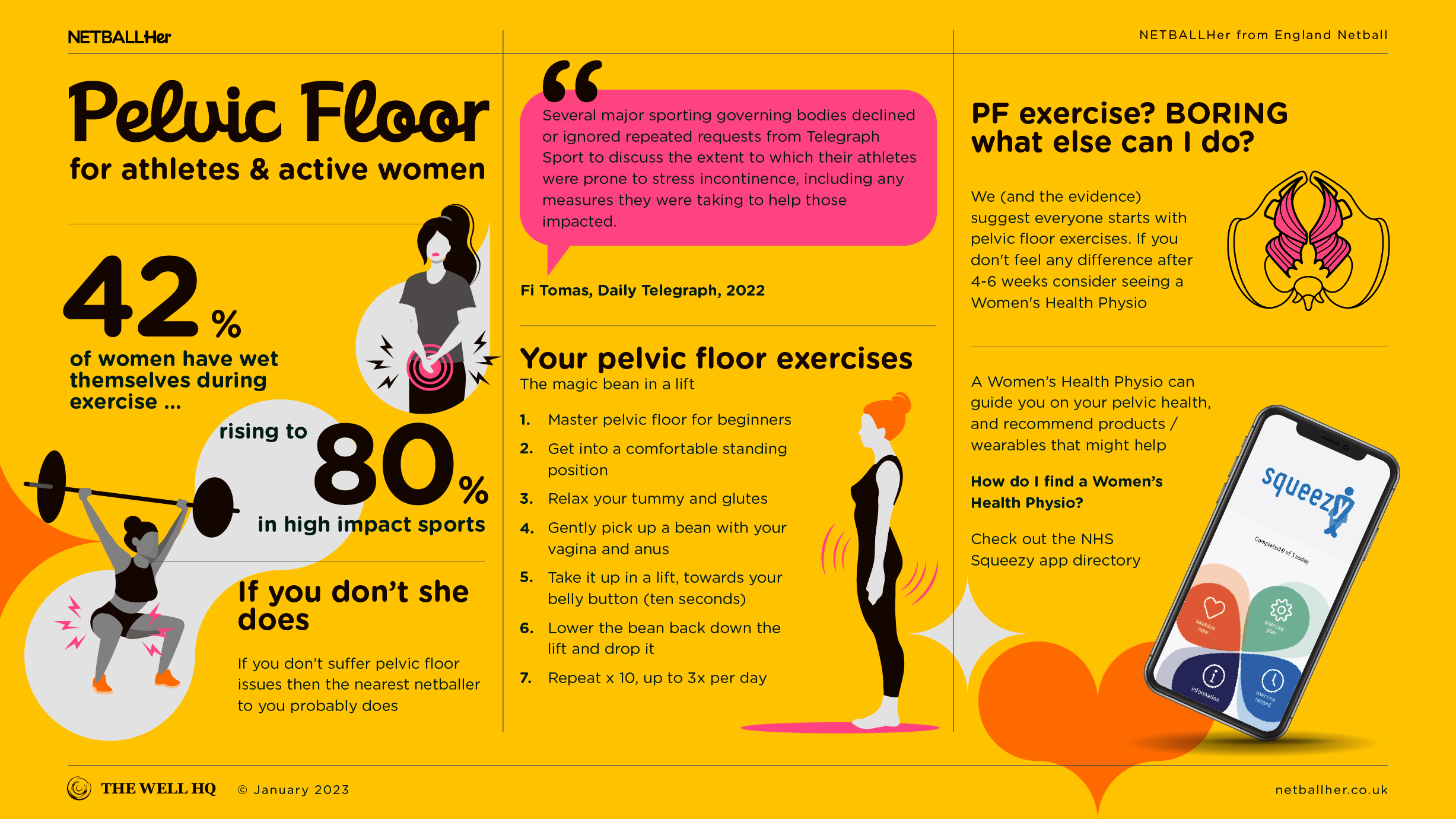Click play for an audio readthrough of this article
Pro player and pelvic floors
In general society, leaking is common and taboo. In professional sport it’s a whole lot more of both.
To give it its proper name, leaking is stress incontinence or “the accidental loss of urine through physical exertion.”
Female athletes are at 177% higher risk of presenting with urinary incontinence symptoms than sedentary women and it’s especially common for those in high-impact sports …
High impact sports such as netball.
Netball is constant running, jumping, landing and stop-starting. It’s impact from below the pelvis and downward pressure from above, and that’s just on-the-job. The fitness regime (cardio, strength and conditioning training) that underpins player fitness will contribute as much; if not more.
The source of the leak
Truth be told, we’re not 100% sure what causes leaking but we know it centres on the pelvic floor. The pelvic floor might be too weak or too strong, or uncoordinated with the rest of the body. But a dominant theory is that leaking in athletes occurs when the pelvic floor is too tight.
To athletes, tight muscle probably sounds like a good thing. But we liken the pelvic floor to a hammock so think of it like this: imagine pouring a bucket of water into a hammock. If the hammock’s too loose it’ll collapse, but if it’s too taut the water will spray off the surface. Neither is good.
We need to train the pelvic floor for just the right amount of give. We need it to be integrated with training so the pelvic floor can adapt, correspond and cope with whatever the body’s going through.
And what the mind’s going through. Athlete or non-athlete, most of us can probably identify with needing to pee when we’re nervous. This is largely because we tense up into soldier posture, hold stress in the stomach, grip and pull the pelvic floor out of the position it wants to be in.
Stress, anxiety and emotion are staples in professional sport so, considering all physical and mental factors, it’s a perfect cocktail for pelvic floor dysfunction. Female athletes may be one jump, breath or strain away from the pelvic floor going into business for itself.
Cue images I’m sure we’ve all seen. Female athletes – from weightlifters to gymnasts – captured leaking on camera. I’m sure many of you have seen it for real, too. In your sports, gyms or practice courts.
The taboo
In 2005, a photographer captured French gymnast Emilie Le Pennec urinating during competition. At London 2012, Ecuadorian weightlifter Maria Alexandra Escobar Guerrero was captured leaking mid-lift.
Twenty years ago, Emilie’s shots wound up on internet fetish sites. Ten years ago, Maria Guerrero became a figure of fun in media all across the world.
Are things better a decade on? Not really. In 2022 I was interviewed by Daily Telegraph journalist Fi Tomas as she tried to shine a light on the important issue of leaking in sport.
A journalist from a big-time paper covering the issue sure sounded like progress. I was chomping at the bit to share my knowledge and experience from sport and coaching; how it’s an endemic problem we need to tackle yesterday; how 41.8% of women have wet themselves during exercise, rising to 80% in high-impact sports …
…
But I was one of the few who spoke up. The sports bodies, federations and NGBs that Fi approached for comment? They shut up shop.
In Fi’s words: “several major sporting governing bodies declined or ignored repeated requests from Telegraph Sport to discuss the extent to which their athletes were prone to stress incontinence, including any measures they were taking to help those impacted.”
Warped messages
A wall of silence, then. And while female athletes are somewhat aware that they need to train their pelvic floors, the message that does get through ‘just keep doing your pelvic floor exercises’. The message is well-meaning enough but emphasis seems to be only on the engage / tighten part of the exercise – when training the pelvic floor to relax is just as important.
Because it’s essentially a collection of muscles. Yes, muscles need to be strong, but they also need to be flexible and co-ordinated, able to adapt with the body’s natural movement, breath, ebb and flow. Tightening and tightening is a recipe for problems.
That’s leaking. It’s UTIs. It’s bed-wetting. It’s pain having sex and inserting tampons. It’s uncontrollable wind. It’s sudden bowel movements.
Silence and wonky messages about the pelvic floor aren’t just knocking adults’ performance either. We know that active pre-teen girls are more likely to wet the bed. We know that many, even by the age of 12, fear leaking during competition. For more, watch our interview, recorded exclusively for England Netball, with Women’s Health Physio Christien Bird.
This is case and point for why we need to teach pelvic health. We need to spread awareness in girls while they’re young and able to build better habits. The stats say one in every three women in the UK general population has some kind of pelvic floor dysfunction and that’s much too much.
As athletes, our odds are higher (somewhere near one in two, or 50%) and that’s even more reason to normalise both the conversation and better pelvic floor practice.
If you can hand-on-heart say you’ve no issues with your pelvic floor today, they’re probably in the post. And if you don’t have issues right now … the stats say your nearest friend or colleague does.
Solutions
There’s no quick-fix in pelvic floors, it’s a discipline we need to master. Daily.
Off-the-shelf products and solutions can help but turning to external solutions and technologies before trying to master the basics is like a tummy tuck before dieting.
As players competing in a high impact sport, our chances of developing pelvic floor problems are pretty much 50/50, and likelihood increases over time.
That’s why we need to commit to daily pelvic floor exercise. We all need to train this crucial piece of body infrastructure so we can rely on its support through all the different movements, motions and states of the day.
It starts with the exercises. If problems remain then it’s onto specialist consultations and maybe tech-based solutions but these shouldn’t be the default. It’s all about the exercises, and it’s all about the talking.
Because all of us, as ambassadors for our sport, need to lead the way in normalising pelvic health. In exercising it, in talking about it, in educating our peers and in passing it onto the next generation. The pelvic floor is not something that should be hidden away: we all have one, and most of us will suffer with issues at some point.
Right now, awareness is just too low when the stakes are this high.
For a video tutorial in pelvic floor exercise, please click here.
A beginner’s guide is here.
As a reminder, the content of the course belongs to The Well HQ. You have permission to access and use the content yourself or, if you are an organisation, for the number of users selected, but are not otherwise permitted to share such content with others, all in accordance with our Course Terms and Conditions.

